You might have heard that blogging is a good way for your company to generate traffic.
But the equation isn’t as simple as, write good content = generate more traffic.
That’s a lie.
Many entrepreneurs struggle to find ways to effectively and reliably generate traffic to their blogs, and wonder “Does this even work?”
And who can blame them?
It took Michael Hyatt more than four years to exceed an average of 1,000 monthly readers. 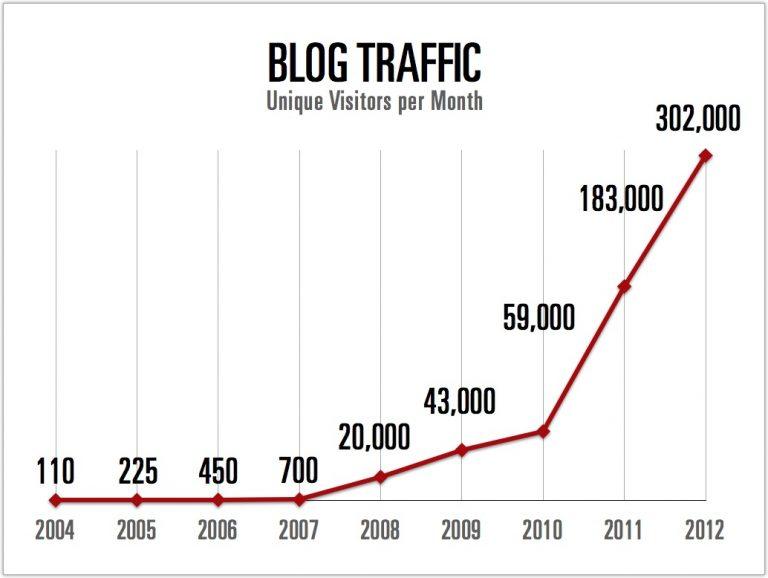
The truth is that without traffic, your blog is just a glorified diary of self-reflection.
If you’re consistently releasing new content, yet for some inexplicable reason, you still aren’t seeing any results, then you’re not alone.
There is so much misinformation and ambiguity surrounding this topic that it is easy to get frustrated and just give up.
But I don’t want you to quit.
If you understand a few battle-proven strategies, you can quickly and easily increase your traffic by 100, 200, even 300% in as little as 60 days.
Best of all, you don’t need to come up with an out-of-the-box strategy. Just reverse engineer what other successful bloggers are doing and follow the leader.
Sound crazy?
Then keep reading.
1. The 5-step Content Process Optinmonster Used to Generate 600k+ Monthly Visits
Optinmonster has one of the most successful online marketing blogs in the world, generating over 600,000 visits each and every month.
And while most people would probably assume that they have a multi-tiered, hyper-complicated traffic generation strategy, nothing could be further from the truth.
In fact, according to their team, nearly all of their success was generated from 5 simple steps.
1. Build Content Pillars that Drive Massive Amounts of Traffic
Most marketers and entrepreneurs have a tendency to focus on the quantity of content that they are producing on their blog.
With all of the “One Post a Day” challenges going around, they often assume that the formula for blogging success is:
More = Better
However, most experts and Optionmonster’s results disagree.
Instead of creating dozens upon dozens of smaller blog posts on any given topic, they create a single piece of “pillar” content, sharing all of the most pertinent information in one breathtaking article.
And as such, search engines and readers love them.
Just look at how their article “16 Ridiculously Simple Ways to Get More Email Subscribers” ranks #1 in Google for the keywords “How to Get More Email Subscribers” and “Get More Email Subscribers.” (and ranks on the first page for a few others too).
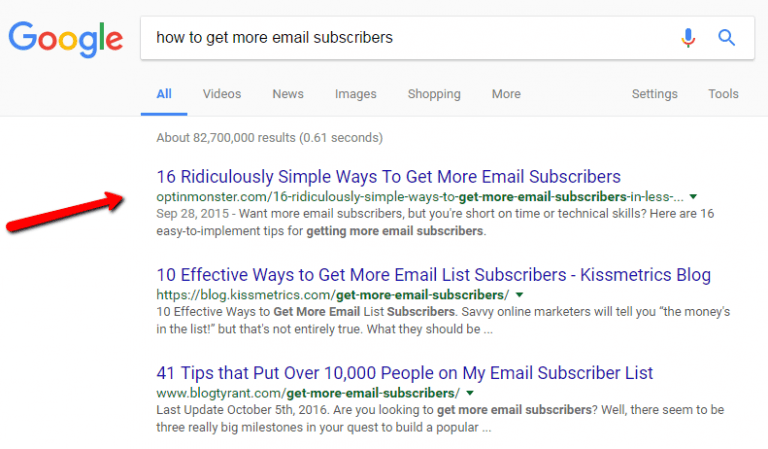
Because of their commitment to article quality, they are able to maintain a first-page ranking, years after their content is published.
2. Refresh Pillar Content Regularly
Unlike other blogs, Optinmonster doesn’t just “set it and forget it” whenever they create badass content pillars.
Instead, they regularly return to that content and update it with new information.
If you look at the picture below, you will notice that their original post was published on September 28, 2015.
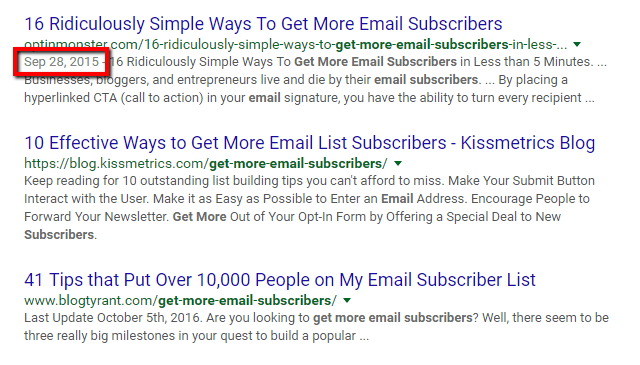
However, when you visit the site, you will notice something else.
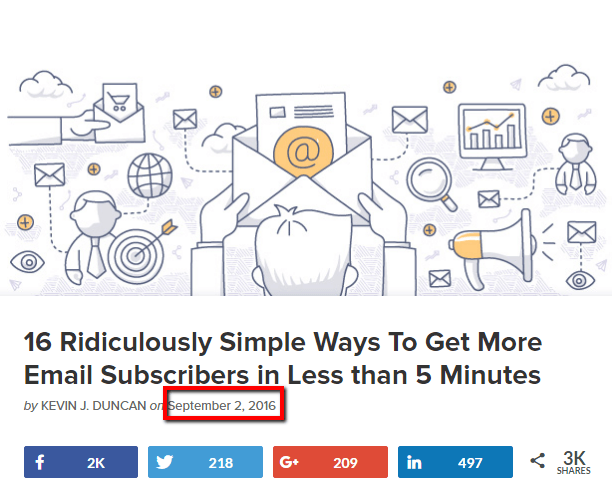
Do you see how the publication date has changed to September 2, 2016?
One of the reasons that Optinmonster is not only able to get ahead, but stay ahead in the traffic and SEO game is because of their commitment to providing the best and most up to date content on the web.
Whenever they publish pillar content, they regularly return to that content and update it.
Their process is pretty simple.
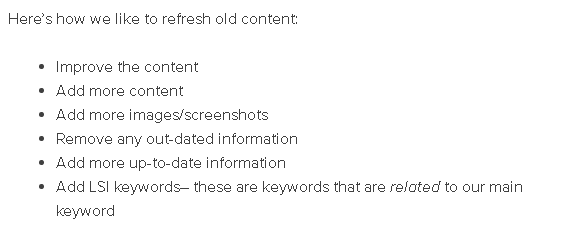
*I don’t have time to dive into LSI keywords in this article, but you can check out Optinmonster’s article “25 Proven Ways to Increase Your Blog Traffic” for more information*
They also noted that whenever they update their content, they manually update the old post and move the publication date forward so that they can keep their comments and social shares.
If you want to stay ahead of the competition and generate tons of traffic to your blog, then regularly revisiting and updating your best content is an absolute must.
3. Crosslink Pillar Content Throughout Your Blog
Crosslinking is a simple SEO tactic that you can use to easily boost the relevance and “findability” of your pillar content.
It’s not like backlinking, which requires the consent of another blog owner or website manager.
All you have to do is regularly add links to your pillar content across the rest of your website.
Here is an example of a crosslink that I recently used in my exit popup article to link back to one of my articles on lead generation.

Oh…
And those two links that I included above the screenshot?
Yea, those are crosslinks too 😉
4. Generate Backlinks to Your Pillar Content
Backlinking is the lifeblood of ranking your content on search engines.
They are what Google uses to determine how relevant your article is to the keywords that you are targeting.
Google wants to know that your content is actually relevant to your audience and they want to see whether other authoritative sites are linking to your content or not.
Before I dive into the exact trick that Optinmonster uses to quickly generate backlinks, I want to point out a very important facet of backlinking that many of you may be unaware of.
Ever since Google’s Panda update, backlink “spamming” has become a death sentence for SEO.
If you want to generate traffic and help your blog grow organically, then you need to focus on the quality of backlinks, and not the quantity.
With that in mind, the tactic used by the team over at Optinmonster is actually a pretty simple one.
All they did was, find websites already mentioning their brand and then ask for a link back to their content.
There are two ways to go about this.
The first is to simply set up your Google alerts to notify you any time your brand is mentioned.
You can then manually review the article and see if the author has linked to any of your content.
Or you can use Buzzsumo and set up an alert anytime your brand is mentioned without a backlink.
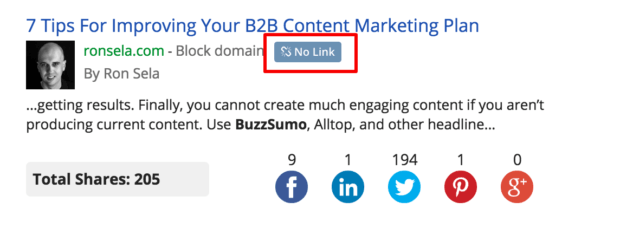
When you notice that a worthwhile company has mentioned your brand, simply email the author and politely ask them if they would be willing to link back to your content.
Even if they have a sufficiently established blog, the probability of getting a link back to your site is high since they mentioned you in the first place.
5. Use Paid Advertising to Boost Pillar Content
Free traffic is fantastic.
We know it, we love it, and if you know how to use it, it can make you a lot of money.
However, if you want to really take your content marketing and blog traffic to the next level, you are going to need to take advantage of paid traffic.
The good news is that you do not need to rely on paid advertising to generate tons of new traffic to your blog.
It simply serves as a secondary tactic to boost the success that you should already have with your content marketing campaigns.
I don’t have time to dive into all of the best practices and actionable strategies for generating traffic through PPC ads, but if you want to learn more, you can check out Neil Patel’s guide on How to Use PPC to Diversify Your Traffic.
2. How 6 Simple Steps Increased Canva’s Traffic by 226% in 60 Days
If you are looking for a way to drastically and (almost) immediately increase blog traffic, then there are few better teachers than Smartblogger.
In their Canva case study, not only do they showcase how they were able to boost their traffic by 226%, but how they were able to accomplish their traffic goals in only 60 days!
How in the world did they pull this off?
With these six simple steps.
1. Reverse Engineer The Competition’s Strategy
The first part of Smart Blogger’s strategy was to reverse engineer their competitor’s content to figure out exactly what was working and how they could fill in the holes in the marketplace.
They realized (as I alluded to earlier in this article) that quality trumps quantity every single time.

So they researched their competition’s content to find topics and content where they could provide even more value to the marketplace.
Just like the folks over at Optinmonster, they utilized Buzzsumo to research their competitors and compile a comprehensive list of potential content ideas.
For example, while I was researching this particular article, I used Buzzsumo and found that the following three articles lead the charge for the keyphrase “Generate More Traffic.”

But here’s the deal.
You can’t just copy your competition’s content.
We have a word for that in the English language… I believe it’s “plagiarism”?
However, what you can do is use parts of your competitors content in conjunction with your own unique ideas and thoughts to create content that your audience will love.
One of the best ways to deepen your market research and find interesting new slants on traditional ideas is to use the online community Quora.
As Smartblogger put it, you should “Use Quora to find interesting angles on popular topics.”
For example, look at some of the related questions that popped up when I searched “How can I increase traffic to my business blog?”
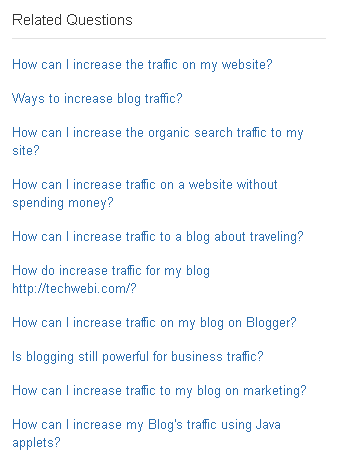
2. Validate Your New Topic for Your Audience
With their list of potential topics created, Canva knew that their work was not done yet.
Instead of just “spraying and praying” they knew that they needed to validate their ideas with their specific audience before they invested time and money into creating killer blog content around those ideas.
After all, nothing is worse than creating an epic content series only to find that your audience actually doesn’t care about what you have to offer.
So, Canva took the direct approach and simply asked their audience outright.
They took a simple poll over email and social media asking them which of their new topics they wanted to read about most.

But they didn’t just stop there.
They knew that people have a tendency to lie to themselves about what is really important in order to look better and feel more secure in their own ego (meaning that poll results are nearly always skewed).
So they took things a step further.
Canva decided to analyze the reading and sharing habits of their audience members.
They went to Buzzsumo (yes you are seeing a pattern with this tool) and searched one of their own articles, clicking the “View Sharers” button.

From there, they could find out what other content that audience member had shared by clicking “View Links Shared”

This is an incredibly powerful tactic that you can use starting today to figure out what your viewers really want.
3. Follow the Numbers
People lie, numbers do not.
One of the key points that Canva mentioned in their case study is that you must always “Follow the data and not your gut”.

Just because you think that you know what your audience is looking for doesn’t mean that you are correct.
Never assume you know what other people want.
Let the data and analytics be your guide and you will never go wrong.
Here is the quality checklist that Canva used to inform their content creation process.
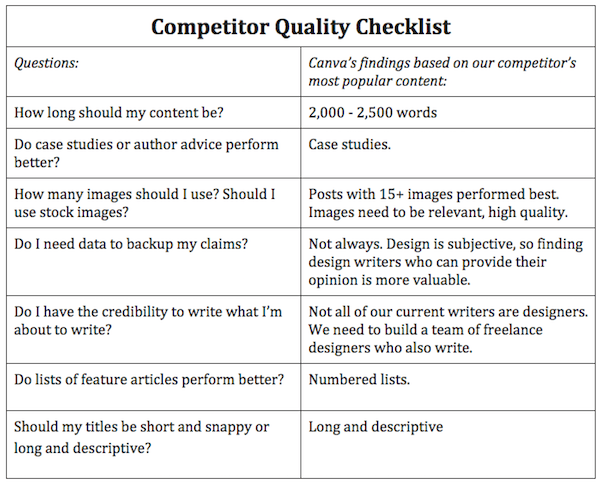
According to Canva this checklist was markedly different from the “gut-based” process that they had been following (unsuccessfully).
4. Find Killer Headlines
Now that you have the requisite data in place to write on a topic that your audience will love, it is time to create a headline you think will resonate with your audience.
But just like you need to rely on data to determine the best topic to write on, you need to make sure that your headlines are based on the numbers and not what sounds good to you.
The trick Canva used is to create a headline, run it for long enough to gather some serious data on it, then change the headline and repost on social media to determine which headline really performs the best.
For example, their article on the importance of long walks for creativity was originally titled “Why Steve Jobs took Long Walks and So Should You.”
After running a couple of tests, they found that this title (which they originally thought was too long) actually performed best.

5. Create Concrete and Credible Content
One of the most important parts of improving your blog traffic is to only post content that is concrete and credible.
Just think about the content that I post here on this blog.
I am presenting facts, figures, and hard evidence to support the claims that I make.
Sure I could just talk for hours and hope that someone would listen, but my opinion is subjective and (often times) wrong.
Facts, however, are not.
As Neil DeGrasse Tyson said, “The good thing about science [in our case data] is that it is true whether or not you believe in it.”

And when it comes to content creation, if you want to be taken in a world full of fakes and frauds, then you want to ensure that the content you are creating is backed up with substantial evidence.
6. Use Images
Many of you might be hesitant about implementing this particular point.
After all, aggregating and using visual content effectively doubles the workload that you can expect for each piece of content that you create.
In fact, it often takes me longer to find the appropriate images for my posts than it does to write the darn things in the first place!
But when you look at the data, I think you will be persuaded.
Canva found that the traffic that they generated increased in accordance with the number of images that they used within each post.

It might increase your workload, but I promise you that it is worth it.
3. Two Guest Blogging Strategies to Grow Traffic by 342%
When it comes to generating backlinks for your website through guest blogging, there are two routes to take.
The first is a tried and true method that can help you generate a respectable number of reasonably authoritative backlinks over time.
The second is a relatively new approach to link building called “link giving” that can help you land massively authoritative backlinks very quickly… if you can pull it off.
1. The “Tried and True” Link Building Approach
The first method for link building is simple.
You write high quality guest articles for high-quality websites to boost your search engine rank and therefore boost organic traffic.
I know, “groundbreaking stuff” right?
Even though this is nothing new, it is a “classic” technique for a reason… It works.
Bamidele Onibalusi, the founder of Effective Business ideas, launched a guest blogging campaign with the sole goal of increasing his organic search traffic through quality backlinks.
Here is a screenshot of his monthly traffic a year before the campaign.

He had three simple parameters for this campaign.

That was it.
The results?
One year after the launch of his campaign, his traffic had grown by over 342%!

2. The “Link Giving” Approach
The second approach that you can take to generate dozens of super high-quality authority backlinks is called link giving.
I was first introduced to this idea by a fellow entrepreneur named Ajay Pagdhal, founder of YouthNoise, Content Viva, and Outreach Mama
The concept is simple in ideation and difficult in execution.
You need to “give” influencers and industry leaders links that are incredibly valuable to them and hope they will return the favor.
Now, I can already hear your thunderous roars of dissent “Sam! How in the world do you expect me to give industry leaders a link that is of any value… my site isn’t that big”
And you are right, odds are, you will never achieve your link building goals by offering influencers a backlink to your site.
But that’s not what you are going to do.
Instead, you are going to start applying to write as a contributor for websites like Forbes, The Huffington Post, and Entrepreneur.
Then, once you have your “in” as a writer for their site, you now have leverage that you can use to secure links for your website from other influencers.
When you are creating contribution articles, be sure to target specific influencers, reaching out and requesting a quote or simply citing some of their work in the body of your content.
Once your article has been approved and published, share the article with your targeted influencer and start the conversation.
This is one tactic that I used with an influencer that landed me a link from Inc.com.
4. Two Unconventional Tactics Neil Patel Used to Grow Crazy Egg’s Traffic by 206%
While Neil delves into the full 7 step process he used to increase Crazy Egg’s traffic by over 200% on his blog, the following 3 steps were the ones that I thought were the most pertinent to this article’s goal.
1. Use Kindle Direct Publishing to Drive Traffic
One of the first uncommon “tricks” that Neil uses to drive traffic is to leverage Kindle Direct Publishing.
While writing and publishing your own ebook might seem like a monumental task, you have to remember that publishing a book on Kindle is actually a lot simpler than you might first think.
There are plenty of easy to implement tactics that can help you get your Kindle book published fast.
You can outsource the writing of the book, aggregate and repackage blog content and sell it at a lower price, or simply write a shorter eBook.
While there are plenty of ways to get a high-quality kindle ebook published, that is not the topic of this article.
In this article, we are focusing on how you can use this ebook to drive traffic to your website.
Luckily, this process is incredibly simple.
The first and easiest step is to simply link back to your content within the pages of your book.
The example that Neil pointed out is a backlink in Chris Guthrie’s book “How to Make Money as an Amazon Associate”

According to Neil, if you are able to land your book on the top 100 list, “Your ebook can send you anywhere from 300 to 3700 extra visitors a month!”
But what if you aren’t making many sales on your ebook?
Is there still a way to redirect visitors who haven’t purchased your book?
Well, actually, there is.
By creating and promoting a congruent giveaway, you can quickly get new traffic to your website as soon as your book is released.
All you have to do is create your giveaway and promote it on the last page of your book’s “Look Inside” preview.
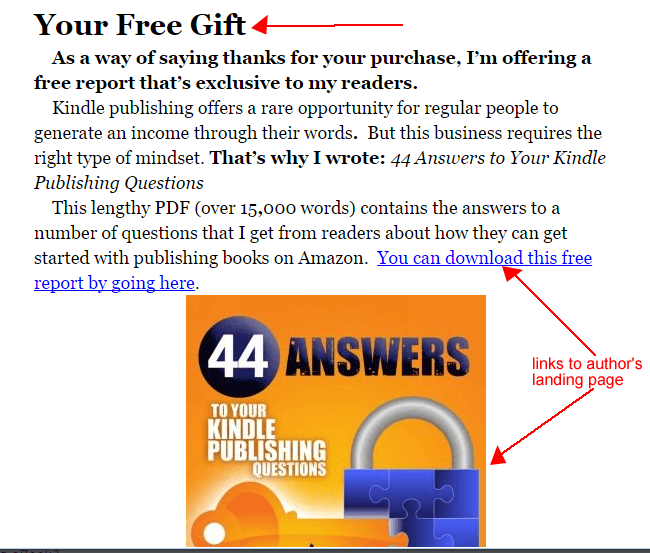
3. Absolutely Own the Long Tail Keyword Game
Ok, so I know that this might not exactly be an “unconventional” tactic, however, most entrepreneurs assume that long tail keyword domination is a thing of the distant past.
After all, this is 2017, and with so much competition online, there is no way that you can still rank for killer long tail keyphrases… is there?
According to Neil, the answer is a resounding “Yes!”
And luckily for us, Neil was gracious enough to detail the three exact steps that he uses to absolutely own the long tail keyword game.
- Use Google Autosuggest
- Use Google Keyword Planner
- Write, write, write.
Let’s use the keyword “increase blog traffic” as an example.
When you search the above key phrase, you will notice that there are almost 9 million other results.

However, by using Google’s auto-suggest option, we can drastically reduce that number.


This one simple tactic cut our competition by more than 50%!
But we aren’t done yet.
Once you have found your ideal long tail keyword, now it’s time to leverage Google’s keyword planner and get some more ideas and find the low-hanging keyword fruit.
Take the exact long tail keyword that you previously used and plug it into your Google Keyword Planner and click “get ideas”.
You will then be presented with a list that looks like this.
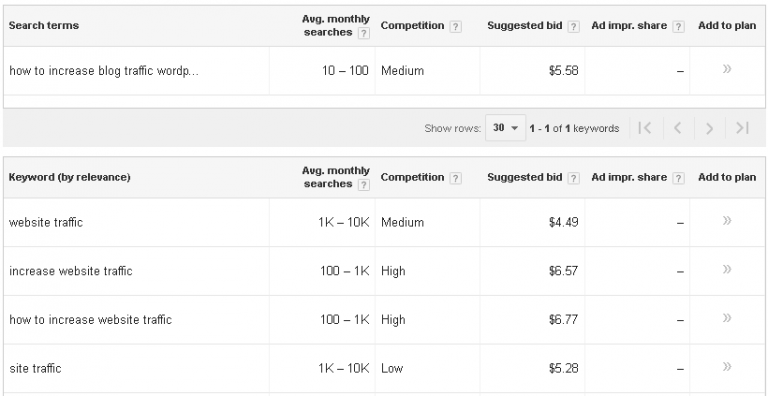
Your goal is to find a low competition long tail keyword.
Once you have your “suspect”, plug and play with the results until you find a keyword where the exact long tail keyword is not targeted exactly in the top three results.
In his article, Neil used the example of the keyword “Weight loss pills for women that work.”
This was the SERP page.

Once you have found your keyword (ideally with fewer than 50,000 competing sites), now all you have to do is write an article ideally, 1,500-3,000 words in length that is optimized for your exact key phrase.
Then rinse and repeat until you dominate all of the longtail keywords in your niche.
5. Moz.com’s 5 Best Tactics for Growing Your Blog Traffic (Almost) Overnight
For those of you who already have a semi-successful blog and are looking for a few simple but effective tactics that you can implement, and not a full blown battle plan, Moz.com is here to help.
In their killer article “21 Tactics to Increase Blog Traffic” they outlined a comprehensive list of simple ways that you can increase traffic to your blog almost instantly.
Here are the five from that list that I found the most effective which have generated the greatest results for me and my blog.
1. Get Plugged into the Community
One of the best things that you can do to quickly drive traffic to your website is to get plugged into niche-relevant online communities.
Find various online groups and masterminds related to your industry and get involved.

Offer value and respond to other member’s questions and comments regularly, occasionally promoting your new content and you will quickly see an influx of traffic from these various sites.
2. Leverage Social Media to Grow Your Organic Reach
One of the most important and often most forgotten parts of creating a successful business is leveraging social media to market your brand and grow your reach.
It doesn’t matter whether you are targeting local hashtags on Instagram or using targeted Facebook ads to get in front of your ideal audience.
You need to find a way that you can build your social media presence to grow your company’s reputation and online standing.
3. Analyze Your Posts
All too often I see marketers who operate under a mindset of “Once it’s done, it’s done”
Unfortunately, nothing could be further from the truth.
Whenever you are creating content, especially content that is a part of a bigger content driving campaign, writing the article is only half the battle.
Once your content has been created, you now need to analyze it and figure out what is driving users to your content and what is driving them away.
Here’s an example of the Google Analytic’s page from the blog Everywhereist
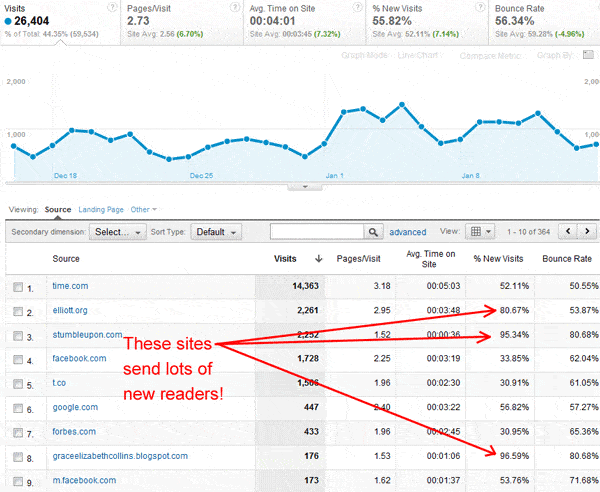
Analyzing your content to uncover audience trends and popular hangouts is an absolute must if you want to drive serious traffic to your blog.
4. Link Back to Your Own Content and Other People’s Content
You remember that talk we had about backlinking and cross-linking earlier in the article?
Well, this tactic is so important, that I figured I would go ahead and mention it again.
If you want to stand out to Google (and other brand’s in your industry) then you need be linking back to your own content and to other people’s content in the body of every article.
Not only will this build authority in the eyes of Google, but it will help you build a certain level of reciprocity with your fellow marketers and entrepreneurs and make it easier for you to build a healthy link profile.
5. Have a Great UX
Great content is nothing if you do not have a clean and easy to navigate user experience that allows people to quickly find what they want.
Too many fantastic companies have fallen into the trap of the “content only” approach and completely neglected their user experience and therefore, increasing their bounce rate and diminishing their authority.
Luckily, a great UX is simple.
Make sure that your website is mobile optimized, use GT Metrix to help speed up page load times, and have each page focus on one or two end goals (e.g. click here or subscribe)
Conclusion
So there you have it.
The tried and tested, battle proven strategies that other marketers and entrepreneurs have used to turn their blogs into traffic generating behemoths.
Analyze the strategies above to develop your own Traffic Generation Campaign and stick with it until you see the results.
They are proven, and if you are willing to put in the work, the results are all but guaranteed.
Do you have any awesome strategies you have used to generate more blog traffic? Any questions that I didn’t answer? Let me know in the comments below.
